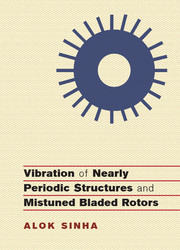Refine search
Actions for selected content:
8124 results in Fluid dynamics and solid mechanics

Symmetry, Phase Modulation and Nonlinear Waves
-
- Published online:
- 30 June 2017
- Print publication:
- 03 July 2017

Vibration of Nearly Periodic Structures and Mistuned Bladed Rotors
-
- Published online:
- 22 June 2017
- Print publication:
- 16 June 2017
EDITORIAL: MATHEMATICAL METHODS FOR APPLICATIONS
-
- Journal:
- The ANZIAM Journal / Volume 58 / Issue 3-4 / April 2017
- Published online by Cambridge University Press:
- 19 June 2017, pp. 209-210
-
- Article
-
- You have access
- Export citation
ANZ VOLUME 58 ISSUE 3-4 COVER AND BACK MATTER
-
- Journal:
- The ANZIAM Journal / Volume 58 / Issue 3-4 / April 2017
- Published online by Cambridge University Press:
- 19 June 2017, pp. b1-b15
-
- Article
-
- You have access
- Export citation
ANZ VOLUME 58 ISSUE 3-4 COVER AND FRONT MATTER
-
- Journal:
- The ANZIAM Journal / Volume 58 / Issue 3-4 / April 2017
- Published online by Cambridge University Press:
- 19 June 2017, pp. f1-f2
-
- Article
-
- You have access
- Export citation
Preface
-
- Book:
- Vibration of Nearly Periodic Structures and Mistuned Bladed Rotors
- Published online:
- 22 June 2017
- Print publication:
- 16 June 2017, pp xi-xiv
-
- Chapter
- Export citation
References
-
- Book:
- Vibration of Nearly Periodic Structures and Mistuned Bladed Rotors
- Published online:
- 22 June 2017
- Print publication:
- 16 June 2017, pp 179-184
-
- Chapter
- Export citation
Acronyms
-
- Book:
- Vibration of Nearly Periodic Structures and Mistuned Bladed Rotors
- Published online:
- 22 June 2017
- Print publication:
- 16 June 2017, pp ix-x
-
- Chapter
- Export citation
1 - Fundamentals of Free Vibration of a Rotationally Periodic Structure
-
- Book:
- Vibration of Nearly Periodic Structures and Mistuned Bladed Rotors
- Published online:
- 22 June 2017
- Print publication:
- 16 June 2017, pp 1-45
-
- Chapter
- Export citation
Appendix A - Fundamentals of Vibration Analysis of a Multidegree of Freedom System
-
- Book:
- Vibration of Nearly Periodic Structures and Mistuned Bladed Rotors
- Published online:
- 22 June 2017
- Print publication:
- 16 June 2017, pp 171-174
-
- Chapter
- Export citation
Copyright page
-
- Book:
- Vibration of Nearly Periodic Structures and Mistuned Bladed Rotors
- Published online:
- 22 June 2017
- Print publication:
- 16 June 2017, pp iv-iv
-
- Chapter
- Export citation
2 - Fundamentals of Forced Vibration of a Mistuned Rotationally Periodic Structure
-
- Book:
- Vibration of Nearly Periodic Structures and Mistuned Bladed Rotors
- Published online:
- 22 June 2017
- Print publication:
- 16 June 2017, pp 46-95
-
- Chapter
- Export citation
Appendices
-
- Book:
- Vibration of Nearly Periodic Structures and Mistuned Bladed Rotors
- Published online:
- 22 June 2017
- Print publication:
- 16 June 2017, pp 171-178
-
- Chapter
- Export citation
Appendix B - Eigenvalues and Eigenvectors of a Circulant Matrix
-
- Book:
- Vibration of Nearly Periodic Structures and Mistuned Bladed Rotors
- Published online:
- 22 June 2017
- Print publication:
- 16 June 2017, pp 175-178
-
- Chapter
- Export citation
Index
-
- Book:
- Vibration of Nearly Periodic Structures and Mistuned Bladed Rotors
- Published online:
- 22 June 2017
- Print publication:
- 16 June 2017, pp 185-186
-
- Chapter
- Export citation
3 - Reduced-Order Models and Response of Nearly Periodic Structures
-
- Book:
- Vibration of Nearly Periodic Structures and Mistuned Bladed Rotors
- Published online:
- 22 June 2017
- Print publication:
- 16 June 2017, pp 96-170
-
- Chapter
- Export citation
Dedication
-
- Book:
- Vibration of Nearly Periodic Structures and Mistuned Bladed Rotors
- Published online:
- 22 June 2017
- Print publication:
- 16 June 2017, pp v-v
-
- Chapter
- Export citation
Contents
-
- Book:
- Vibration of Nearly Periodic Structures and Mistuned Bladed Rotors
- Published online:
- 22 June 2017
- Print publication:
- 16 June 2017, pp vi-viii
-
- Chapter
- Export citation
10 - Rigid Body Collision with Liquid Surface
- from Part IV - Collisions of Solid Bodies with Liquid
-
- Book:
- Collision Phenomena in Liquids and Solids
- Published online:
- 13 July 2017
- Print publication:
- 15 June 2017, pp 473-486
-
- Chapter
- Export citation
6 - Drop Impacts with Liquid Pools and Layers
- from Part II - Drop Impacts onto Liquid Surfaces
-
- Book:
- Collision Phenomena in Liquids and Solids
- Published online:
- 13 July 2017
- Print publication:
- 15 June 2017, pp 255-320
-
- Chapter
- Export citation
